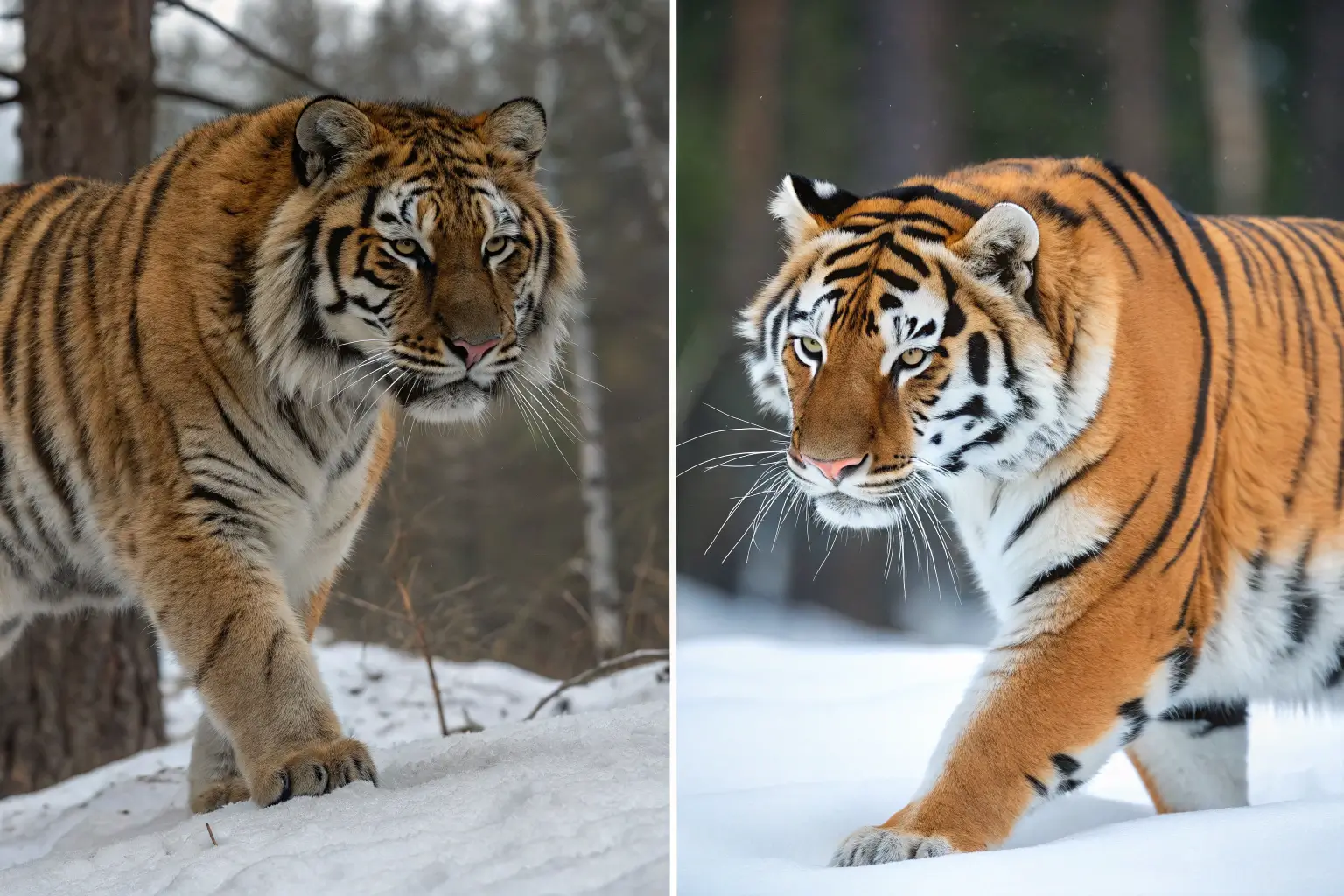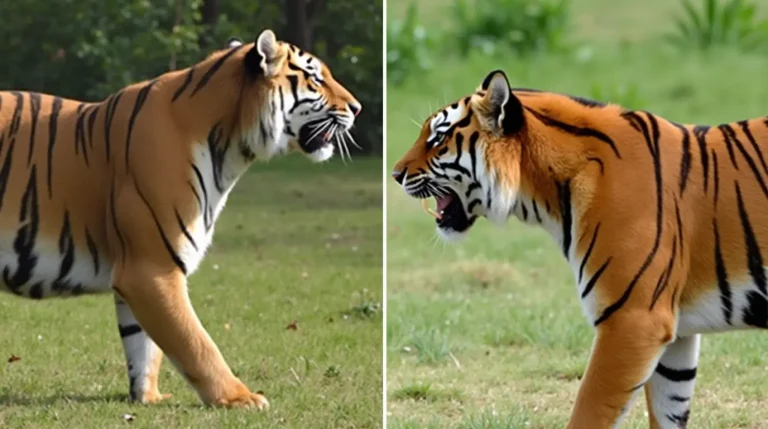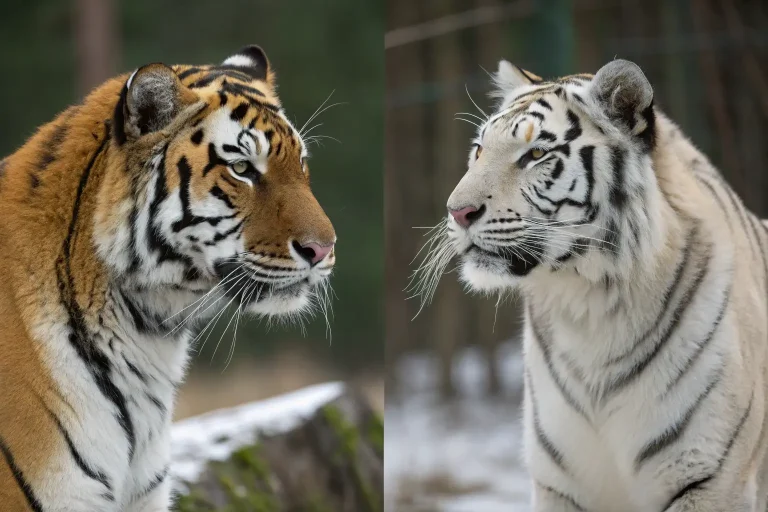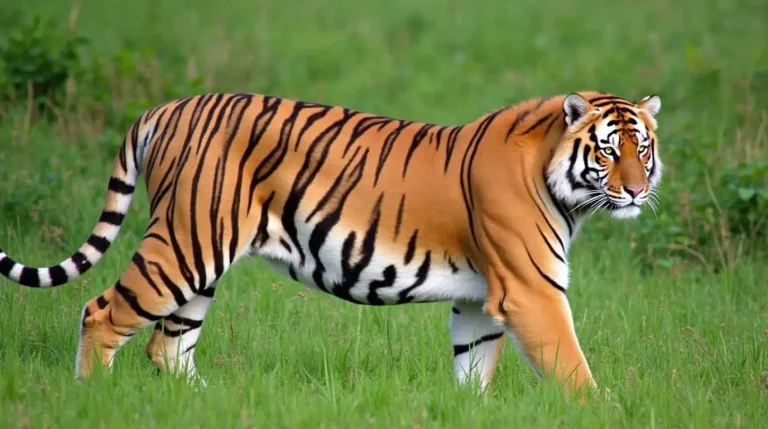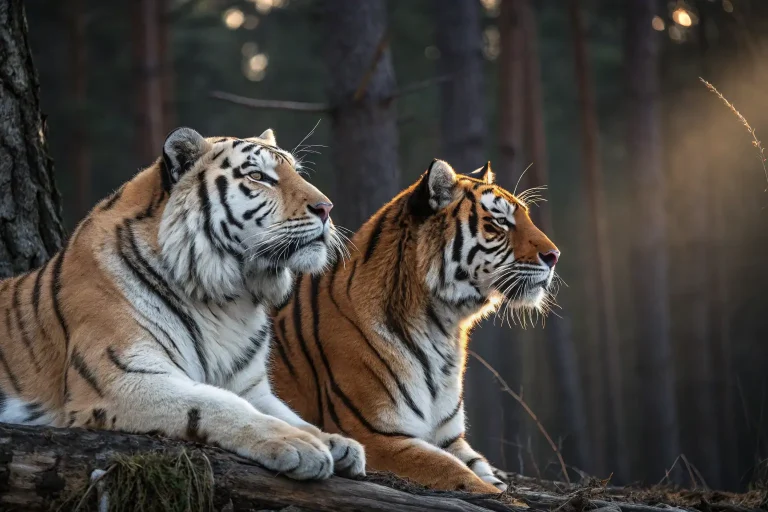Siberian Amur Tiger vs Bengal Tiger: 7 Key Differences Explored
We’ve all marveled at the raw power and beauty of tigers – nature’s perfect predators. But when comparing the Siberian Amur tiger vs Bengal tiger, even seasoned wildlife enthusiasts might struggle to identify their distinct characteristics. These magnificent big cats may share a family tree, but they’ve evolved with fascinating adaptations that set them worlds apart.
From the snow-covered forests of Russia to the steamy jungles of India, these apex predators have developed unique traits that help them thrive in their respective habitats. Whether you’re a wildlife photographer, conservation advocate, or simply captivated by these striped wonders, understanding the differences between these two tiger subspecies reveals much about nature’s incredible adaptability.
In this comprehensive comparison, we’ll explore everything from size discrepancies and habitat preferences to hunting strategies and conservation challenges. Ready to discover which tiger truly reigns supreme? Let’s dive into the fascinating world of these magnificent big cats.
Introduction
Tigers have long captivated human imagination with their striking appearance, raw power, and mysterious nature. As the largest members of the cat family, they represent the perfect blend of beauty and danger that commands our respect and awe. The Siberian Amur tiger and Bengal tiger stand as two of the most iconic subspecies, often featured in nature documentaries and conservation campaigns.
Understanding the distinctions between the Siberian Amur tiger vs Bengal tiger isn’t merely an academic exercise – it’s crucial for conservation efforts targeting each subspecies. With all tiger populations facing serious threats, recognizing their unique needs and challenges helps wildlife experts develop tailored protection strategies.
Did you know that despite their fearsome reputation, tigers are surprisingly good swimmers? Both Siberian and Bengal tigers enjoy water and can swim several kilometers without tiring – a rare trait among big cats that hints at their evolutionary journey and specialized adaptations.
Species Overview
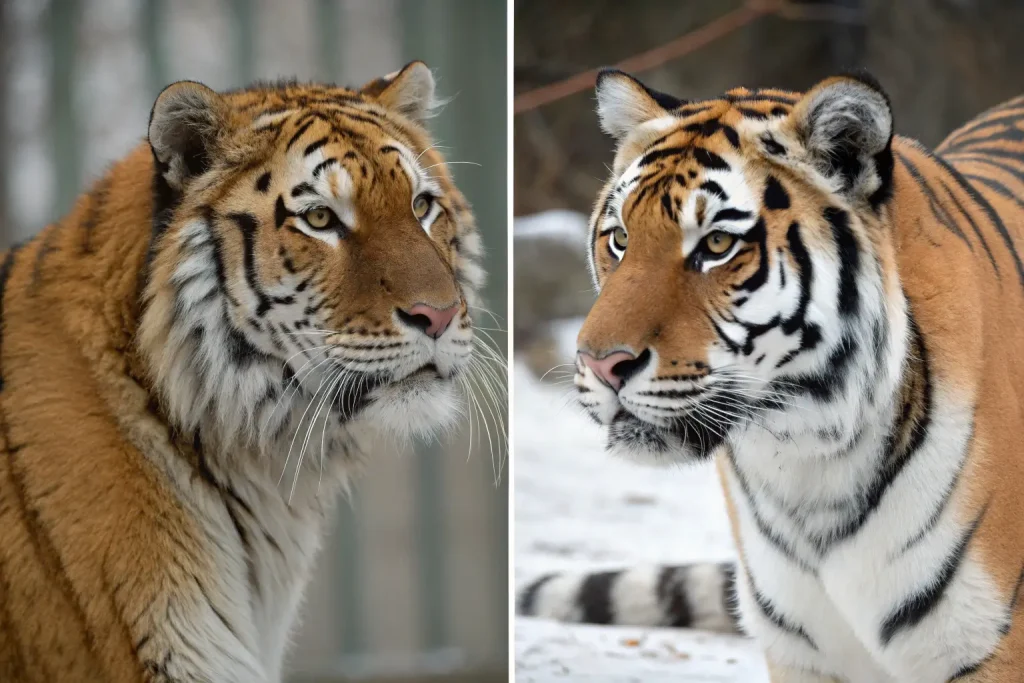
Scientific Classification
Both tigers belong to the same species, Panthera tigris, but represent different subspecies:
- Siberian Amur tiger: Panthera tigris altaica (also called Amur tiger or Russian tiger)
- Bengal tiger: Panthera tigris tigris
These classifications reflect their genetic differences and geographical isolation that have led to distinct evolutionary paths.
Physical Characteristics
When comparing Siberian Amur tiger vs Bengal tiger, size is one of the most noticeable differences:
Siberian Amur Tiger:
- Weight: Males 400-675 pounds (180-306 kg); females 200-370 pounds (90-167 kg)
- Length: 10-12 feet (3-3.7 meters) including tail
- Height: About 3-3.5 feet (0.9-1.1 meters) at shoulder
- Coat: Pale orange with fewer, wider stripes; longer, thicker fur
- Features: Broader face, smaller ears, thicker ruff around neck
Bengal Tiger:
- Weight: Males 400-550 pounds (180-250 kg); females 220-350 pounds (100-160 kg)
- Length: 8-10 feet (2.4-3 meters) including tail
- Height: About 3 feet (0.9 meters) at shoulder
- Coat: Deep orange with dense, narrow black stripes; shorter fur
- Features: More angular face, larger ears, slimmer build
The Siberian Amur tiger generally has a bulkier frame with more substantial leg bones and paws – adaptations for traversing snow and withstanding frigid temperatures. Meanwhile, the Bengal tiger’s build reflects its need for agility and speed in dense jungle environments.
Subspecies Variations
While we’re focusing on the Siberian Amur tiger vs Bengal tiger comparison, it’s worth noting that these represent just two of the six recognized tiger subspecies surviving today:
- Siberian (Amur) tiger
- Bengal tiger
- Indochinese tiger
- Malayan tiger
- Sumatran tiger
- South China tiger (functionally extinct in the wild)
Three additional subspecies (Javan, Bali, and Caspian tigers) have gone extinct within the last century, highlighting the precarious state of tiger conservation globally.
Habitat and Distribution
Natural Habitat
Siberian Amur Tiger:
The Siberian tiger has adapted to some of the harshest environments on Earth. These resilient cats inhabit:
- Temperate deciduous forests
- Coniferous taiga forests
- Mountainous regions
- Areas with heavy snowfall and temperatures dropping to -50°F (-45°C)
Bengal Tiger:
In stark contrast, Bengal tigers thrive in:
- Tropical and subtropical environments
- Dense jungles and mangrove swamps
- Grasslands and savannas
- Areas with high humidity and temperatures often exceeding 104°F (40°C)
This fundamental habitat difference between Siberian Amur tiger vs Bengal tiger has shaped nearly every aspect of their physical characteristics and behavior.
Geographic Range
Siberian Amur Tiger:
- Primarily eastern Russia (Primorye and Khabarovsk regions)
- Small populations in northern China
- Possibly a few individuals in North Korea
- Historically found throughout northeastern China, Korean peninsula, and eastern Russia
Bengal Tiger:
- Primarily India (holding approximately 70% of the population)
- Also found in Bangladesh, Nepal, and Bhutan
- Small population in western Myanmar
- Historically ranged throughout the Indian subcontinent, including Pakistan
The Siberian tiger’s range has contracted dramatically, with these cats now confined to approximately 4% of their historical territory. Bengal tigers have experienced similar range contraction but maintain a somewhat wider distribution.
Adaptations
The stark contrast in environments has led to significant adaptations when comparing Siberian Amur tiger vs Bengal tiger:
Siberian Amur Tiger Adaptations:
- Thicker fur with an insulating fat layer up to 2 inches (5 cm) thick
- Larger paws that act as natural “snowshoes”
- Whiter coloration for snow camouflage
- More efficient metabolism to survive long periods between meals
- Larger territories (up to 1,000 square kilometers) due to scarcer prey
Bengal Tiger Adaptations:
- Shorter, sleeker coat for heat dissipation
- More vibrant orange coloration for jungle camouflage
- Stronger swimming abilities for navigating waterways
- Smaller territories (about 20-400 square kilometers) in prey-rich environments
- More varied hunting techniques for diverse prey species
These adaptations highlight nature’s remarkable ability to shape predators to their specific environments, even within the same species.
Diet and Feeding Habits
What They Eat
When comparing the dietary preferences in the Siberian Amur tiger vs Bengal tiger matchup, we see both similarities and differences:
Siberian Amur Tiger Diet:
- Primary prey: Manchurian elk, wild boar, sika deer
- Secondary prey: Musk deer, Siberian roe deer, moose
- Occasional: Badgers, bears, lynx, wolves, small mammals, fish
Bengal Tiger Diet:
- Primary prey: Sambar deer, chital, wild boar, gaur
- Secondary prey: Barasingha, nilgai, water buffalo
- Occasional: Crocodiles, leopards, sloth bears, small mammals
Both subspecies are opportunistic and will adjust their diet based on prey availability, but Siberian tigers often take down larger prey to sustain themselves through harsh winters.
Hunting or Foraging Behavior
The hunting strategies employed in the Siberian Amur tiger vs Bengal tiger comparison reflect their different environments:
Siberian Amur Tiger Hunting:
- Mainly hunts at dawn and dusk
- Often travels long distances (up to 50 km a day) searching for prey
- Relies heavily on stalking through snow, using sound-dampening effects
- May cache (hide) large kills and return to them over several days
- Hunting success rate: approximately 1 in 10 attempts
Bengal Tiger Hunting:
- Can hunt throughout the day, though most active at night
- Uses dense vegetation for cover during stalks
- Often hunts near water sources where prey congregates
- Rarely needs to cache kills due to faster decomposition in hot climate
- Hunting success rate: approximately 1 in 20 attempts
Both tigers employ the classic feline ambush technique – stalking to within 20-30 meters before a powerful, explosive sprint and takedown.
Dietary Needs
The caloric requirements demonstrate another interesting facet of the Siberian Amur tiger vs Bengal tiger comparison:
Siberian Amur Tiger:
- Requires approximately 15-18 pounds (7-8 kg) of meat daily
- Can consume up to 100 pounds (45 kg) in a single feeding
- May fast for up to two weeks between successful hunts
- Requires higher fat content for cold weather survival
Bengal Tiger:
- Requires approximately 10-15 pounds (4.5-7 kg) of meat daily
- Typically consumes smaller amounts more frequently
- Rarely goes more than a week without feeding
- Greater access to water influences hunting and feeding patterns
These differences in food consumption patterns directly correlate to their environmental challenges and prey availability.
Behavior and Social Structure
Social Behavior
In the Siberian Amur tiger vs Bengal tiger comparison, both subspecies maintain similar social structures:
Siberian Amur Tiger:
- Extremely solitary, with minimal social interaction
- Territories rarely overlap except for mating
- Greater spacing between individuals due to scarcer resources
- May exhibit increased tolerance during harsh winter months
Bengal Tiger:
- Primarily solitary, but more social interactions observed
- Female territories may slightly overlap
- Higher density populations in prey-rich areas
- Occasionally seen sharing kills (particularly among related females)
Despite their reputation as loners, recent research with camera traps has revealed more complex social dynamics than previously understood, especially among Bengal tigers in protected reserves.
Communication
Both tiger subspecies use similar communication methods, with subtle differences:
Siberian Amur Tiger Communication:
- Scent marking more concentrated near territory borders
- Less frequent but louder vocalizations that carry further in open terrain
- Tracks and scrapes in snow provide visual communication
- Face-to-face encounters rare but potentially more aggressive
Bengal Tiger Communication:
- Extensive scent marking throughout territory
- More frequent but sometimes softer vocalizations
- Complex body language more visible in densely populated areas
- Higher likelihood of visual encounters with other tigers
Both use vocalizations including roars, chuffs, moans, and hisses, along with scent marking via urine, feces, and clawing trees. These communication methods maintain social boundaries and signal reproductive readiness.
Mating and Reproduction
The reproductive patterns in the Siberian Amur tiger vs Bengal tiger comparison show interesting adaptations to their respective environments:
Siberian Amur Tiger:
- Breeding typically January-March
- Gestation: 3-3.5 months
- Average litter: 2-4 cubs (smaller litters more common)
- Cubs remain with mother for 18-24 months
- Sexual maturity: 4-5 years
- Cubs have lower survival rate (approximately 50%)
Bengal Tiger:
- Can breed year-round with slight increases during cooler months
- Gestation: 3-3.5 months
- Average litter: 2-6 cubs (larger litters more common)
- Cubs remain with mother for 18-30 months
- Sexual maturity: 3-4 years
- Cubs have higher survival rate in optimal habitat (up to 60-70%)
These reproductive differences reflect evolutionary adaptations to their respective environmental pressures, with Siberian tigers investing more resources in fewer offspring due to harsher survival conditions.
Conservation Status
Endangerment Level
The conservation status reveals critical concerns in the Siberian Amur tiger vs Bengal tiger comparison:
Siberian Amur Tiger:
- IUCN Status: Endangered
- Population: Approximately 500-550 individuals in the wild
- Population trend: Stable to slightly increasing
- 95% of population concentrated in Russian Far East
Bengal Tiger:
- IUCN Status: Endangered
- Population: Approximately 2,500-3,000 individuals in the wild
- Population trend: Stable in protected areas, declining elsewhere
- India hosts roughly 70% of all wild Bengal tigers
While both subspecies face serious threats, the significantly smaller Siberian tiger population makes it more vulnerable to extinction despite recent conservation successes.
Threats
Both tiger subspecies face numerous threats, with some variation:
Siberian Amur Tiger Threats:
- Poaching for traditional medicine markets
- Prey depletion due to illegal hunting
- Habitat fragmentation from logging and development
- Human-tiger conflict in villages
- Limited genetic diversity due to population bottleneck
- Climate change affecting prey distribution
Bengal Tiger Threats:
- Habitat loss due to agricultural expansion
- Poaching for skin, bones, and other body parts
- Human-tiger conflict in densely populated regions
- Infrastructure development fragmenting habitat
- Decreasing prey base
- Natural disasters (particularly in mangrove habitats)
In the Siberian Amur tiger vs Bengal tiger conservation challenge, both face similar threats but at different scales and intensities.
Conservation Efforts
Dedicated conservation programs target both subspecies:
Siberian Amur Tiger Conservation:
- Russian-led anti-poaching brigades
- Sino-Russian transboundary protected areas
- Reintroduction programs in former range areas
- GPS tracking of individuals
- Genetic research to address inbreeding concerns
- International breeding programs in zoos
Bengal Tiger Conservation:
- India’s Project Tiger (launched 1973)
- Tiger reserves with buffer zones
- Wildlife corridors connecting habitat fragments
- Community-based conservation initiatives
- Relocation programs from overpopulated reserves
- Anti-poaching technology including drones and camera traps
These conservation efforts represent some of the most comprehensive wildlife protection programs in the world, though challenges remain daunting for both subspecies.
Interesting Facts
When discussing Siberian Amur tiger vs Bengal tiger trivia, several fascinating details emerge:
Genetic Uniqueness: The Siberian tiger has the least genetic diversity of all tiger subspecies due to a population bottleneck about 10,000 years ago during the last ice age.
White Bengal Tigers: White Bengal tigers (not albinos, but tigers with a recessive gene causing white fur and blue eyes) exist only in the Bengal subspecies, never in Siberian tigers.
Record Holders: The largest tiger ever recorded was a Siberian male that weighed 1,025 pounds (465 kg) – though most modern Siberians are considerably smaller due to hunting pressure selecting for smaller individuals.
Swimming Champions: Bengal tigers in the Sundarbans mangrove forests regularly swim between islands and have been recorded swimming up to 8 km in ocean water.
Winter Adaptations: Siberian tigers grow winter and summer coats, with winter fur up to 7 cm long compared to the Bengal’s consistent 2-3 cm coat.
Cultural Significance: Bengal tigers appear in ancient Indian art dating back over 3,000 years and feature prominently in Hindu mythology.
Presidential Connection: Siberian tigers were studied directly by Vladimir Putin, who participated in a tracking and collaring expedition in 2008.
Territorial Marking: A single Bengal tiger can mark over 40 trees in a single day with scent, scratches and spraying.
Jumping Ability: Despite their size differences, both Siberian and Bengal tigers can leap up to 10 meters horizontally and 5 meters vertically.
Bite Force: The Siberian tiger has a slightly stronger bite force at approximately 1,000 PSI compared to the Bengal’s 950 PSI – both among the strongest of all carnivores.
These fascinating differences and similarities in the Siberian Amur tiger vs Bengal tiger comparison demonstrate nature’s incredible diversity even within a single species.
Tips for Observing Tigers in the Wild
For wildlife enthusiasts hoping to witness these magnificent creatures in their natural habitat, here are some essential tips when planning Siberian Amur tiger vs Bengal tiger viewing experiences:
For Siberian Amur Tigers:
- Visit Russia’s Sikhote-Alin Reserve or Land of the Leopard National Park
- Plan trips during winter when tracks are visible in snow
- Be prepared for extreme cold (-20°F/-30°C not uncommon)
- Understand sightings are extremely rare even with guides
- Consider volunteering with conservation organizations for better access
For Bengal Tigers:
- Visit India’s top tiger reserves: Ranthambore, Bandhavgarh, Kanha, or Kaziranga
- Travel during dry season (March-June) when vegetation is thinner
- Book multiple game drives to increase chances
- Morning drives typically offer better sighting opportunities
- Hire experienced local guides who know individual tigers’ territories
General Tiger Viewing Tips:
- Never approach on foot or leave vehicles in tiger territory
- Respect park rules and ranger instructions
- Use binoculars and telephoto lenses (minimum 300mm)
- Be patient – successful sightings often require multiple attempts
- Practice ethical wildlife viewing by maintaining appropriate distance
While observing tigers in the wild is challenging, the experience of seeing these magnificent predators in their natural environment is unmatched by any zoo or safari park encounter.
Role in the Ecosystem
Ecological Importance
As apex predators, both subspecies play crucial roles in their ecosystems:
Siberian Amur Tiger Ecological Role:
- Controls ungulate populations (especially wild boar and deer species)
- Prevents overgrazing of forest vegetation
- Limits mesopredator populations (wolves, lynx)
- Creates carrion resources for scavenger species
- Shapes prey behavior and distribution across vast territories
Bengal Tiger Ecological Role:
- Regulates herbivore populations in diverse habitats
- Prevents ecosystem degradation from ungulate overpopulation
- Creates microhabitats through predation patterns
- Influences prey species’ evolution and adaptation
- Maintains balance between competing herbivore species
In the Siberian Amur tiger vs Bengal tiger ecological impact assessment, both function as keystone species whose influence extends throughout their respective food webs.
Impact of Decline
The consequences of tiger population declines are far-reaching:
Consequences of Siberian Tiger Decline:
- Wild boar population explosions leading to agricultural conflicts
- Altered forest composition due to increased herbivore browsing
- Expanded wolf territories and increased livestock predation
- Cascading effects on small mammal and bird populations
- Loss of umbrella species protection for countless other species
Consequences of Bengal Tiger Decline:
- Deer overpopulation affecting forest regeneration
- Changed herbivore behavior with less natural movement
- Disrupted nutrient cycling in ecosystems
- Increased human-wildlife conflict as other predators fill niches
- Reduced ecotourism revenue for conservation funding
These ecological disruptions demonstrate why the Siberian Amur tiger vs Bengal tiger conservation battle must be won for both subspecies – the health of entire ecosystems depends on their survival.
Conclusion
The comparison between the Siberian Amur tiger vs Bengal tiger reveals nature’s remarkable ability to adapt a single species to dramatically different environments. From the snowy forests of the Russian Far East to the steamy jungles of India, these magnificent predators have evolved distinct characteristics while maintaining the essential qualities that make tigers such successful hunters.
The Siberian tiger stands as a testament to cold-weather adaptation with its massive size, thick coat, and solitary nature perfect for its resource-scarce environment. Meanwhile, the Bengal tiger showcases adaptations to tropical conditions with its more vibrant coloration, varied hunting techniques, and slightly more social flexibility.
Both subspecies face serious threats to their survival, with habitat loss and poaching leading the list of challenges. Their future depends on continued conservation efforts, international cooperation, and public support. By understanding the unique needs and characteristics of each tiger subspecies, we can better protect these irreplaceable predators.
Whether you’re drawn to the mystique of the massive Siberian tiger or captivated by the jungle prowess of the Bengal tiger, one thing is certain – these magnificent cats deserve our admiration and protection. Their continued survival represents one of conservation’s greatest challenges and potentially one of its greatest success stories.
Frequently Asked Questions
Which is bigger: the Siberian Amur tiger or Bengal tiger?
The Siberian Amur tiger is generally larger than the Bengal tiger. Male Siberian tigers typically weigh 400-675 pounds (180-306 kg) compared to male Bengal tigers at 400-550 pounds (180-250 kg). Siberian tigers also have heavier bones, larger paws, and thicker fur, making them appear even more massive.
Can Siberian and Bengal tigers interbreed?
Yes, Siberian and Bengal tigers can interbreed and produce fertile offspring. However, this rarely happens in the wild due to their geographical separation. In captivity, hybridization has occurred, though most reputable conservation programs avoid crossbreeding to maintain the genetic distinctiveness of each subspecies.
Which tiger subspecies has the largest population?
The Bengal tiger has a significantly larger population than the Siberian Amur tiger. Current estimates place wild Bengal tigers at approximately 2,500-3,000 individuals, while wild Siberian tigers number around 500-550. This makes the Bengal tiger the most numerous tiger subspecies in the wild today.
Do Siberian tigers have different hunting strategies than Bengal tigers?
Yes, their hunting strategies differ based on their environments. Siberian tigers often track prey over long distances in snow, can cache large kills for days, and typically take down larger prey like elk and wild boar. Bengal tigers use dense vegetation for stalking, target a more diverse prey base, and rarely cache kills due to warmer temperatures causing faster decomposition.
Which subspecies is more endangered?
While both are classified as Endangered on the IUCN Red List, the Siberian Amur tiger faces a higher extinction risk due to its significantly smaller population (approximately 500 individuals) compared to the Bengal tiger (2,500-3,000 individuals). The Siberian tiger’s limited genetic diversity also makes it more vulnerable to disease and environmental changes.
Can you see white tigers in the wild?
White tigers exist only within the Bengal tiger subspecies and are extremely rare in the wild. The last documented wild white tiger was shot in 1958. All white tigers in captivity today descend from a single wild-caught white cub named Mohan. The white coloration results from a recessive gene and is not a separate subspecies.
What should I do if I encounter a tiger in the wild?
If you encounter a tiger in the wild: don’t run (this can trigger predatory instincts), maintain eye contact, back away slowly, make yourself appear larger, speak in a firm voice, and if possible, climb above the tiger’s reach. However, such encounters are extremely rare as tigers typically avoid humans. Always follow park rangers’ safety instructions when in tiger habitat.

